Assessing Risk Management, Patient Safety, and Teamwork in Hospitals
VerifiedAdded on 2020/07/23
|19
|4373
|148
Project
AI Summary
This research project assesses the practices of hospitals, specifically in the UK healthcare sector, regarding risk management, patient safeguarding, and team management. The project includes a literature review analyzing existing research on risk assessment, patient protection, and team dynamics. The research employs an inductive approach and interpretivism philosophy, utilizing secondary data analysis to evaluate the effectiveness of hospital practices. Key areas of focus include evaluating risk management strategies, patient safety protocols, and team management techniques within hospitals. The study aims to identify areas for improvement and offers recommendations for enhancing risk management, patient safeguarding, and team management practices. The project is structured into two parts: a research proposal outlining the study's objectives, methodology, and ethical considerations, followed by the complete research project, including an introduction, literature review, methodology, findings, and conclusions.
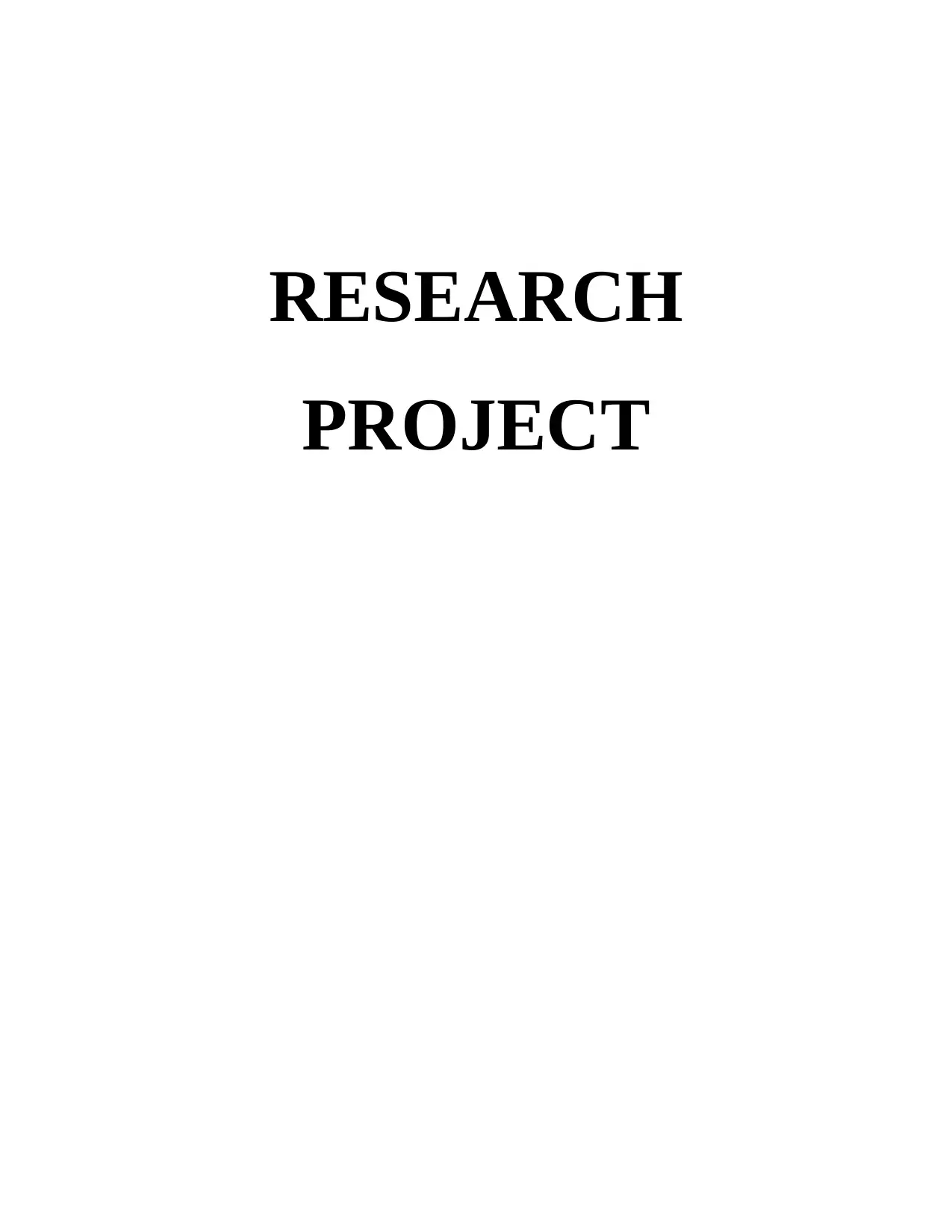
RESEARCH
PROJECT
PROJECT
Paraphrase This Document
Need a fresh take? Get an instant paraphrase of this document with our AI Paraphraser
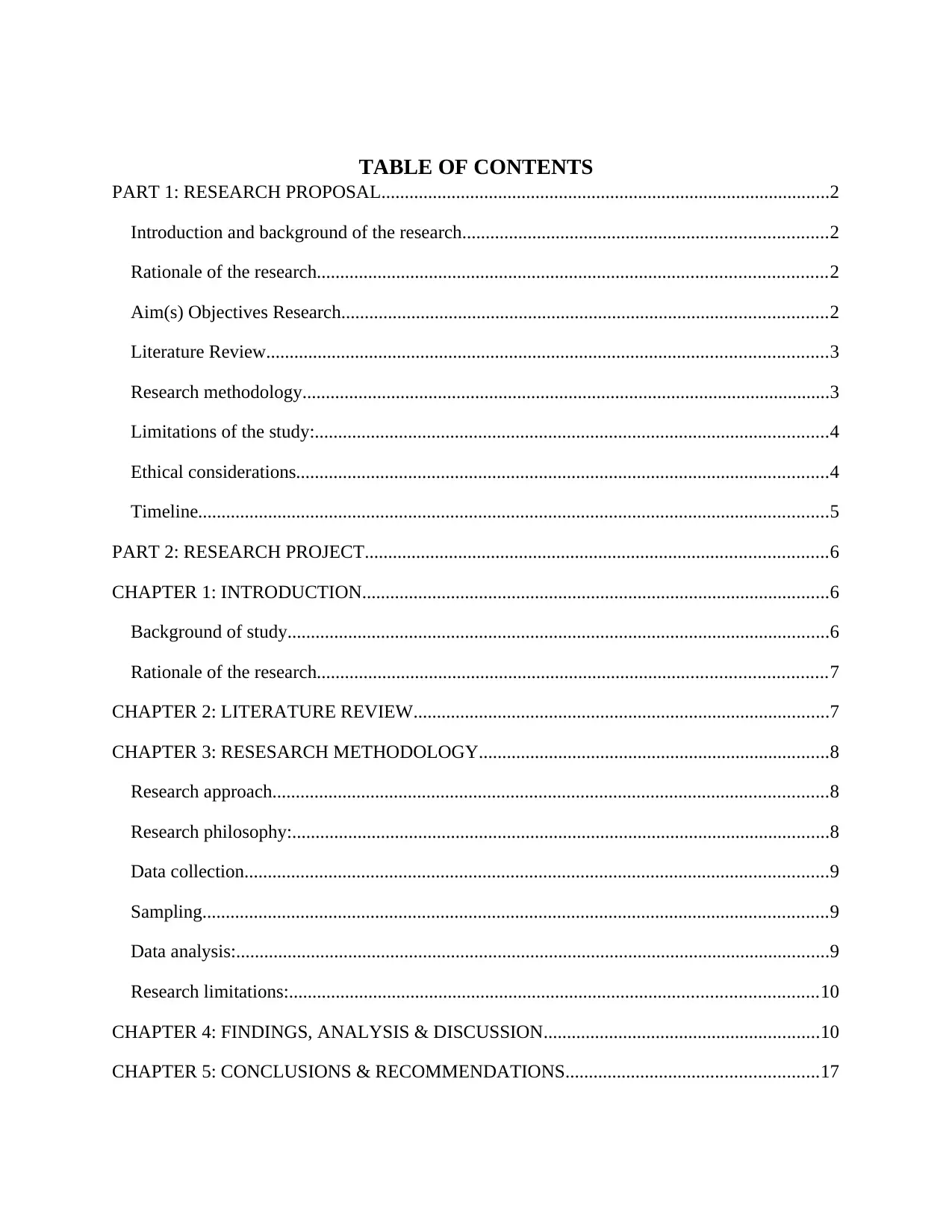
TABLE OF CONTENTS
PART 1: RESEARCH PROPOSAL................................................................................................2
Introduction and background of the research..............................................................................2
Rationale of the research.............................................................................................................2
Aim(s) Objectives Research........................................................................................................2
Literature Review........................................................................................................................3
Research methodology.................................................................................................................3
Limitations of the study:..............................................................................................................4
Ethical considerations..................................................................................................................4
Timeline.......................................................................................................................................5
PART 2: RESEARCH PROJECT...................................................................................................6
CHAPTER 1: INTRODUCTION....................................................................................................6
Background of study....................................................................................................................6
Rationale of the research.............................................................................................................7
CHAPTER 2: LITERATURE REVIEW.........................................................................................7
CHAPTER 3: RESESARCH METHODOLOGY...........................................................................8
Research approach.......................................................................................................................8
Research philosophy:...................................................................................................................8
Data collection.............................................................................................................................9
Sampling......................................................................................................................................9
Data analysis:...............................................................................................................................9
Research limitations:.................................................................................................................10
CHAPTER 4: FINDINGS, ANALYSIS & DISCUSSION...........................................................10
CHAPTER 5: CONCLUSIONS & RECOMMENDATIONS......................................................17
PART 1: RESEARCH PROPOSAL................................................................................................2
Introduction and background of the research..............................................................................2
Rationale of the research.............................................................................................................2
Aim(s) Objectives Research........................................................................................................2
Literature Review........................................................................................................................3
Research methodology.................................................................................................................3
Limitations of the study:..............................................................................................................4
Ethical considerations..................................................................................................................4
Timeline.......................................................................................................................................5
PART 2: RESEARCH PROJECT...................................................................................................6
CHAPTER 1: INTRODUCTION....................................................................................................6
Background of study....................................................................................................................6
Rationale of the research.............................................................................................................7
CHAPTER 2: LITERATURE REVIEW.........................................................................................7
CHAPTER 3: RESESARCH METHODOLOGY...........................................................................8
Research approach.......................................................................................................................8
Research philosophy:...................................................................................................................8
Data collection.............................................................................................................................9
Sampling......................................................................................................................................9
Data analysis:...............................................................................................................................9
Research limitations:.................................................................................................................10
CHAPTER 4: FINDINGS, ANALYSIS & DISCUSSION...........................................................10
CHAPTER 5: CONCLUSIONS & RECOMMENDATIONS......................................................17

REFERENCES..............................................................................................................................18
⊘ This is a preview!⊘
Do you want full access?
Subscribe today to unlock all pages.

Trusted by 1+ million students worldwide
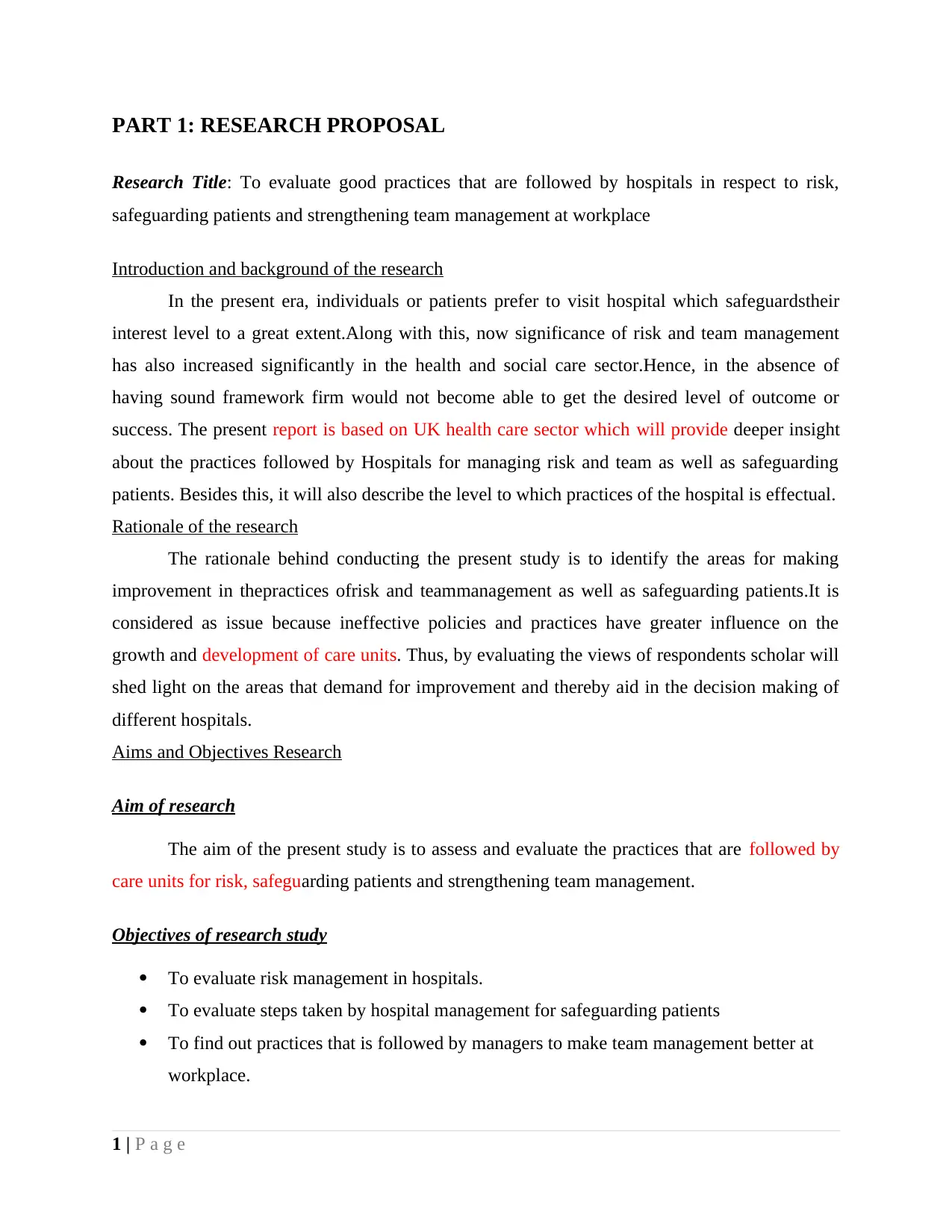
PART 1: RESEARCH PROPOSAL
Research Title: To evaluate good practices that are followed by hospitals in respect to risk,
safeguarding patients and strengthening team management at workplace
Introduction and background of the research
In the present era, individuals or patients prefer to visit hospital which safeguardstheir
interest level to a great extent.Along with this, now significance of risk and team management
has also increased significantly in the health and social care sector.Hence, in the absence of
having sound framework firm would not become able to get the desired level of outcome or
success. The present report is based on UK health care sector which will provide deeper insight
about the practices followed by Hospitals for managing risk and team as well as safeguarding
patients. Besides this, it will also describe the level to which practices of the hospital is effectual.
Rationale of the research
The rationale behind conducting the present study is to identify the areas for making
improvement in thepractices ofrisk and teammanagement as well as safeguarding patients.It is
considered as issue because ineffective policies and practices have greater influence on the
growth and development of care units. Thus, by evaluating the views of respondents scholar will
shed light on the areas that demand for improvement and thereby aid in the decision making of
different hospitals.
Aims and Objectives Research
Aim of research
The aim of the present study is to assess and evaluate the practices that are followed by
care units for risk, safeguarding patients and strengthening team management.
Objectives of research study
To evaluate risk management in hospitals.
To evaluate steps taken by hospital management for safeguarding patients
To find out practices that is followed by managers to make team management better at
workplace.
1 | P a g e
Research Title: To evaluate good practices that are followed by hospitals in respect to risk,
safeguarding patients and strengthening team management at workplace
Introduction and background of the research
In the present era, individuals or patients prefer to visit hospital which safeguardstheir
interest level to a great extent.Along with this, now significance of risk and team management
has also increased significantly in the health and social care sector.Hence, in the absence of
having sound framework firm would not become able to get the desired level of outcome or
success. The present report is based on UK health care sector which will provide deeper insight
about the practices followed by Hospitals for managing risk and team as well as safeguarding
patients. Besides this, it will also describe the level to which practices of the hospital is effectual.
Rationale of the research
The rationale behind conducting the present study is to identify the areas for making
improvement in thepractices ofrisk and teammanagement as well as safeguarding patients.It is
considered as issue because ineffective policies and practices have greater influence on the
growth and development of care units. Thus, by evaluating the views of respondents scholar will
shed light on the areas that demand for improvement and thereby aid in the decision making of
different hospitals.
Aims and Objectives Research
Aim of research
The aim of the present study is to assess and evaluate the practices that are followed by
care units for risk, safeguarding patients and strengthening team management.
Objectives of research study
To evaluate risk management in hospitals.
To evaluate steps taken by hospital management for safeguarding patients
To find out practices that is followed by managers to make team management better at
workplace.
1 | P a g e
Paraphrase This Document
Need a fresh take? Get an instant paraphrase of this document with our AI Paraphraser
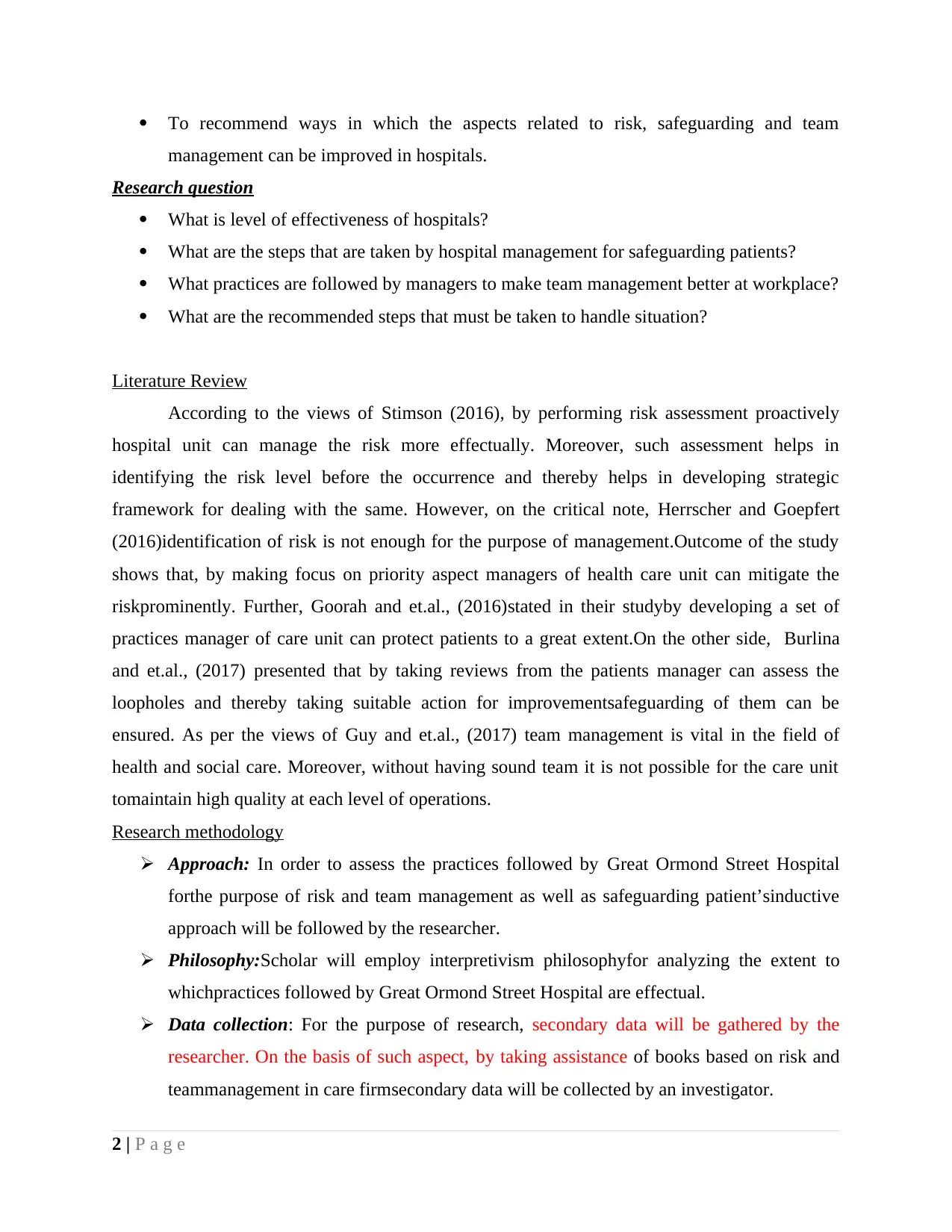
To recommend ways in which the aspects related to risk, safeguarding and team
management can be improved in hospitals.
Research question
What is level of effectiveness of hospitals?
What are the steps that are taken by hospital management for safeguarding patients?
What practices are followed by managers to make team management better at workplace?
What are the recommended steps that must be taken to handle situation?
Literature Review
According to the views of Stimson (2016), by performing risk assessment proactively
hospital unit can manage the risk more effectually. Moreover, such assessment helps in
identifying the risk level before the occurrence and thereby helps in developing strategic
framework for dealing with the same. However, on the critical note, Herrscher and Goepfert
(2016)identification of risk is not enough for the purpose of management.Outcome of the study
shows that, by making focus on priority aspect managers of health care unit can mitigate the
riskprominently. Further, Goorah and et.al., (2016)stated in their studyby developing a set of
practices manager of care unit can protect patients to a great extent.On the other side, Burlina
and et.al., (2017) presented that by taking reviews from the patients manager can assess the
loopholes and thereby taking suitable action for improvementsafeguarding of them can be
ensured. As per the views of Guy and et.al., (2017) team management is vital in the field of
health and social care. Moreover, without having sound team it is not possible for the care unit
tomaintain high quality at each level of operations.
Research methodology
Approach: In order to assess the practices followed by Great Ormond Street Hospital
forthe purpose of risk and team management as well as safeguarding patient’sinductive
approach will be followed by the researcher.
Philosophy:Scholar will employ interpretivism philosophyfor analyzing the extent to
whichpractices followed by Great Ormond Street Hospital are effectual.
Data collection: For the purpose of research, secondary data will be gathered by the
researcher. On the basis of such aspect, by taking assistance of books based on risk and
teammanagement in care firmsecondary data will be collected by an investigator.
2 | P a g e
management can be improved in hospitals.
Research question
What is level of effectiveness of hospitals?
What are the steps that are taken by hospital management for safeguarding patients?
What practices are followed by managers to make team management better at workplace?
What are the recommended steps that must be taken to handle situation?
Literature Review
According to the views of Stimson (2016), by performing risk assessment proactively
hospital unit can manage the risk more effectually. Moreover, such assessment helps in
identifying the risk level before the occurrence and thereby helps in developing strategic
framework for dealing with the same. However, on the critical note, Herrscher and Goepfert
(2016)identification of risk is not enough for the purpose of management.Outcome of the study
shows that, by making focus on priority aspect managers of health care unit can mitigate the
riskprominently. Further, Goorah and et.al., (2016)stated in their studyby developing a set of
practices manager of care unit can protect patients to a great extent.On the other side, Burlina
and et.al., (2017) presented that by taking reviews from the patients manager can assess the
loopholes and thereby taking suitable action for improvementsafeguarding of them can be
ensured. As per the views of Guy and et.al., (2017) team management is vital in the field of
health and social care. Moreover, without having sound team it is not possible for the care unit
tomaintain high quality at each level of operations.
Research methodology
Approach: In order to assess the practices followed by Great Ormond Street Hospital
forthe purpose of risk and team management as well as safeguarding patient’sinductive
approach will be followed by the researcher.
Philosophy:Scholar will employ interpretivism philosophyfor analyzing the extent to
whichpractices followed by Great Ormond Street Hospital are effectual.
Data collection: For the purpose of research, secondary data will be gathered by the
researcher. On the basis of such aspect, by taking assistance of books based on risk and
teammanagement in care firmsecondary data will be collected by an investigator.
2 | P a g e
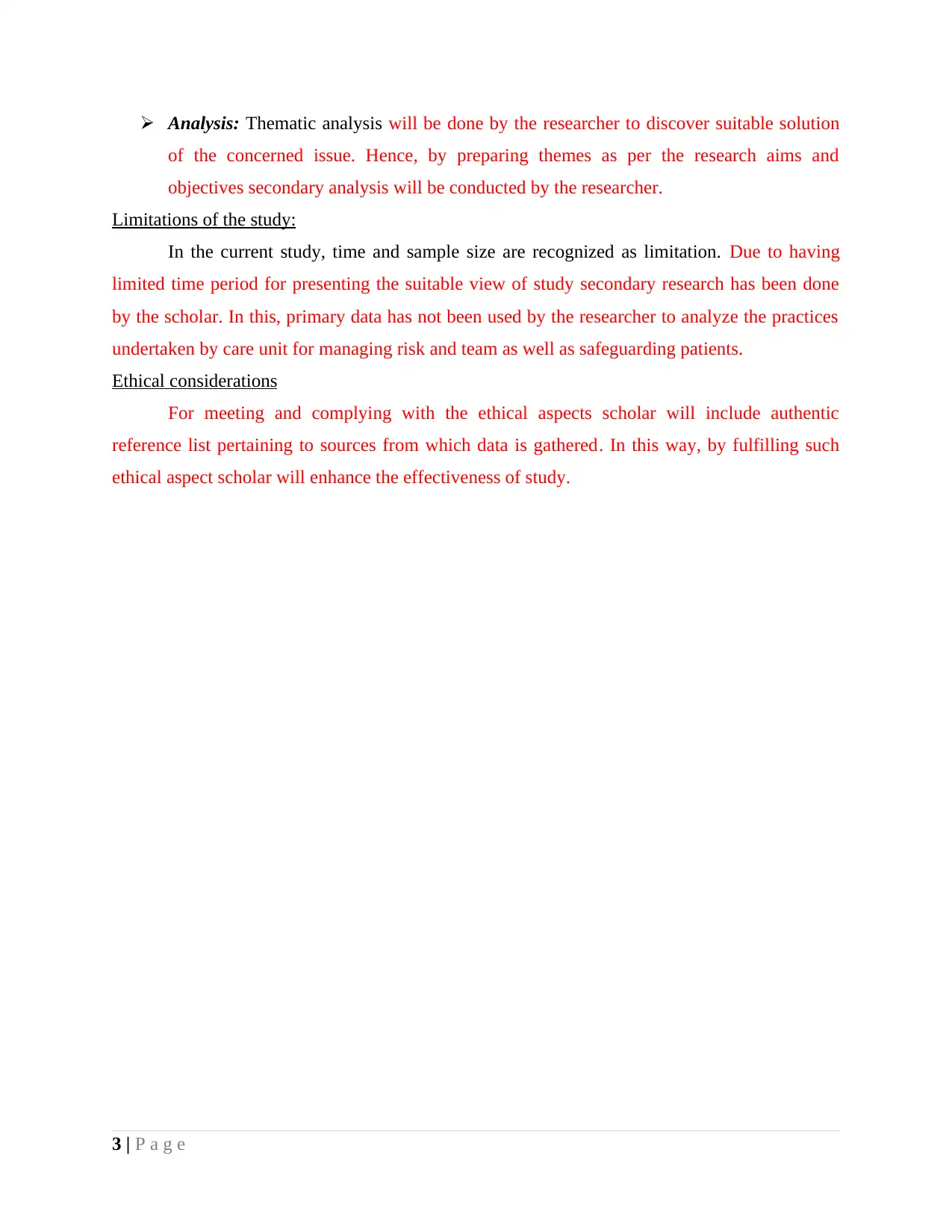
Analysis: Thematic analysis will be done by the researcher to discover suitable solution
of the concerned issue. Hence, by preparing themes as per the research aims and
objectives secondary analysis will be conducted by the researcher.
Limitations of the study:
In the current study, time and sample size are recognized as limitation. Due to having
limited time period for presenting the suitable view of study secondary research has been done
by the scholar. In this, primary data has not been used by the researcher to analyze the practices
undertaken by care unit for managing risk and team as well as safeguarding patients.
Ethical considerations
For meeting and complying with the ethical aspects scholar will include authentic
reference list pertaining to sources from which data is gathered. In this way, by fulfilling such
ethical aspect scholar will enhance the effectiveness of study.
3 | P a g e
of the concerned issue. Hence, by preparing themes as per the research aims and
objectives secondary analysis will be conducted by the researcher.
Limitations of the study:
In the current study, time and sample size are recognized as limitation. Due to having
limited time period for presenting the suitable view of study secondary research has been done
by the scholar. In this, primary data has not been used by the researcher to analyze the practices
undertaken by care unit for managing risk and team as well as safeguarding patients.
Ethical considerations
For meeting and complying with the ethical aspects scholar will include authentic
reference list pertaining to sources from which data is gathered. In this way, by fulfilling such
ethical aspect scholar will enhance the effectiveness of study.
3 | P a g e
⊘ This is a preview!⊘
Do you want full access?
Subscribe today to unlock all pages.

Trusted by 1+ million students worldwide
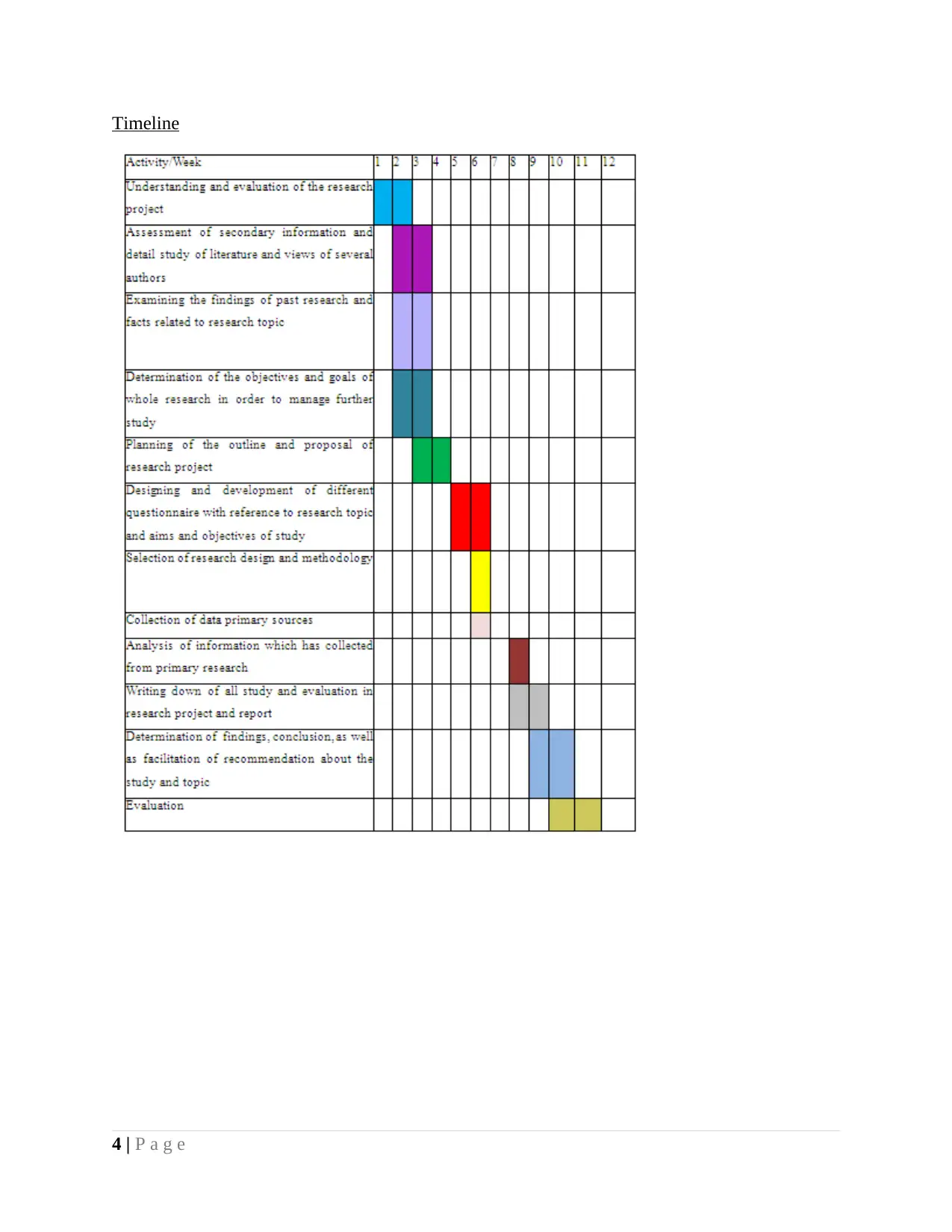
Timeline
4 | P a g e
4 | P a g e
Paraphrase This Document
Need a fresh take? Get an instant paraphrase of this document with our AI Paraphraser
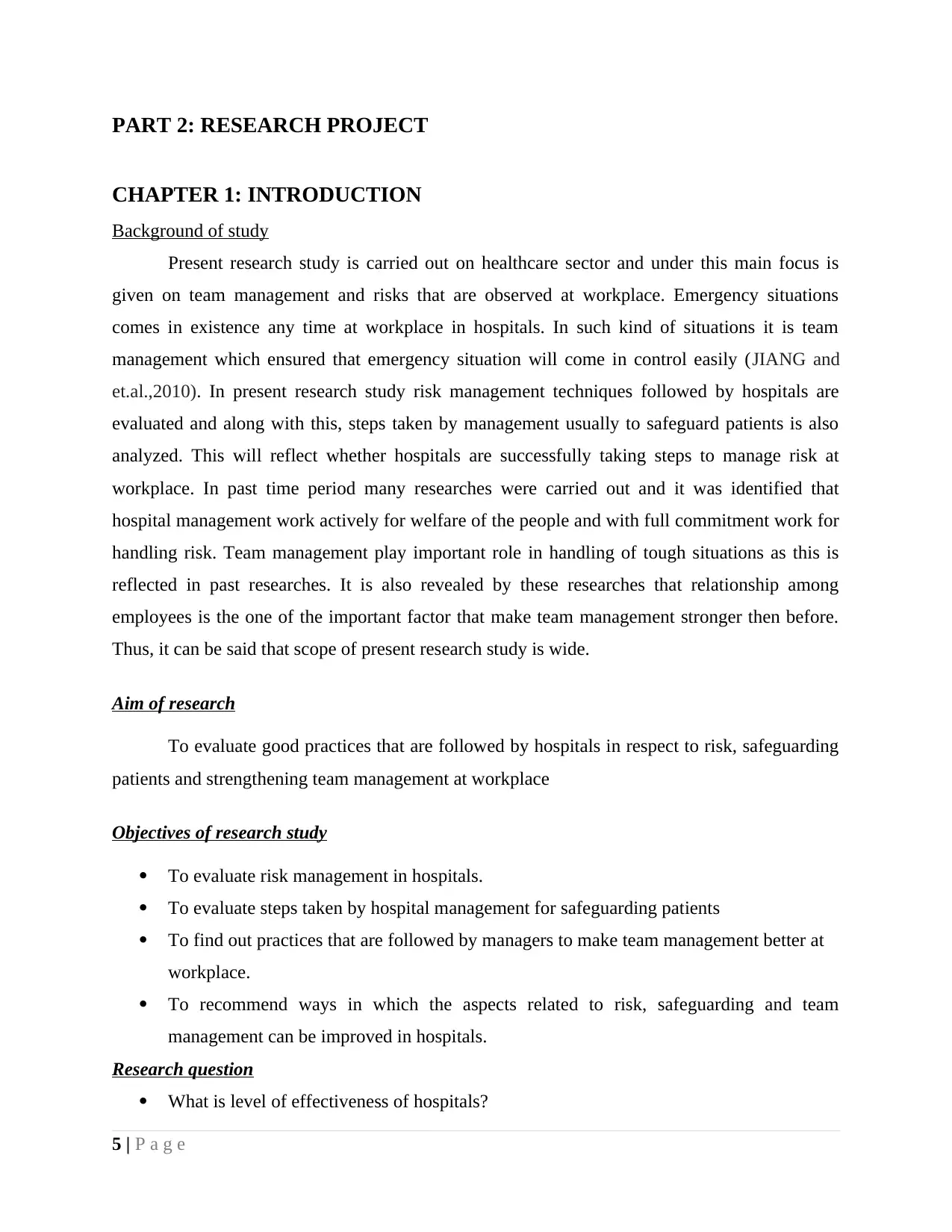
PART 2: RESEARCH PROJECT
CHAPTER 1: INTRODUCTION
Background of study
Present research study is carried out on healthcare sector and under this main focus is
given on team management and risks that are observed at workplace. Emergency situations
comes in existence any time at workplace in hospitals. In such kind of situations it is team
management which ensured that emergency situation will come in control easily (JIANG and
et.al.,2010). In present research study risk management techniques followed by hospitals are
evaluated and along with this, steps taken by management usually to safeguard patients is also
analyzed. This will reflect whether hospitals are successfully taking steps to manage risk at
workplace. In past time period many researches were carried out and it was identified that
hospital management work actively for welfare of the people and with full commitment work for
handling risk. Team management play important role in handling of tough situations as this is
reflected in past researches. It is also revealed by these researches that relationship among
employees is the one of the important factor that make team management stronger then before.
Thus, it can be said that scope of present research study is wide.
Aim of research
To evaluate good practices that are followed by hospitals in respect to risk, safeguarding
patients and strengthening team management at workplace
Objectives of research study
To evaluate risk management in hospitals.
To evaluate steps taken by hospital management for safeguarding patients
To find out practices that are followed by managers to make team management better at
workplace.
To recommend ways in which the aspects related to risk, safeguarding and team
management can be improved in hospitals.
Research question
What is level of effectiveness of hospitals?
5 | P a g e
CHAPTER 1: INTRODUCTION
Background of study
Present research study is carried out on healthcare sector and under this main focus is
given on team management and risks that are observed at workplace. Emergency situations
comes in existence any time at workplace in hospitals. In such kind of situations it is team
management which ensured that emergency situation will come in control easily (JIANG and
et.al.,2010). In present research study risk management techniques followed by hospitals are
evaluated and along with this, steps taken by management usually to safeguard patients is also
analyzed. This will reflect whether hospitals are successfully taking steps to manage risk at
workplace. In past time period many researches were carried out and it was identified that
hospital management work actively for welfare of the people and with full commitment work for
handling risk. Team management play important role in handling of tough situations as this is
reflected in past researches. It is also revealed by these researches that relationship among
employees is the one of the important factor that make team management stronger then before.
Thus, it can be said that scope of present research study is wide.
Aim of research
To evaluate good practices that are followed by hospitals in respect to risk, safeguarding
patients and strengthening team management at workplace
Objectives of research study
To evaluate risk management in hospitals.
To evaluate steps taken by hospital management for safeguarding patients
To find out practices that are followed by managers to make team management better at
workplace.
To recommend ways in which the aspects related to risk, safeguarding and team
management can be improved in hospitals.
Research question
What is level of effectiveness of hospitals?
5 | P a g e
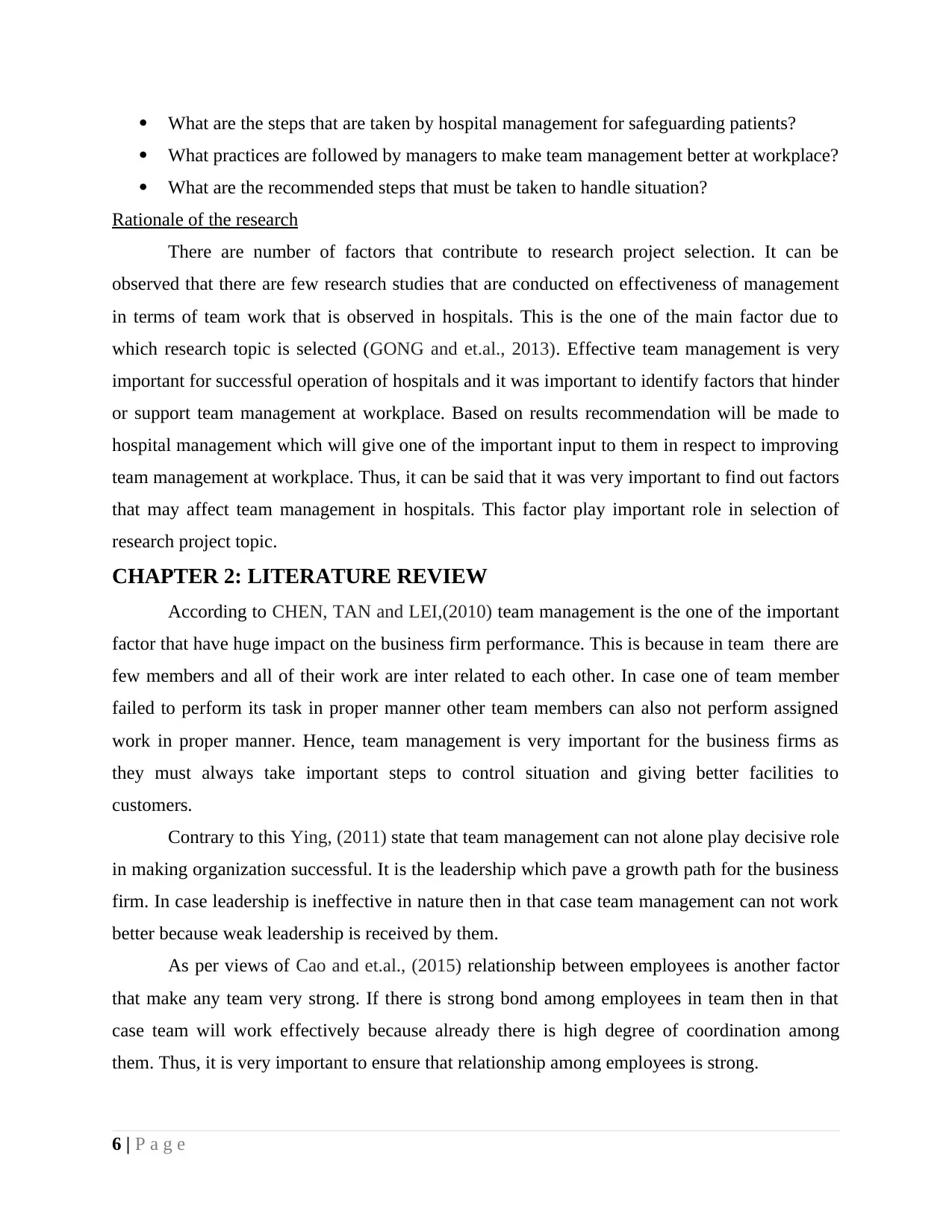
What are the steps that are taken by hospital management for safeguarding patients?
What practices are followed by managers to make team management better at workplace?
What are the recommended steps that must be taken to handle situation?
Rationale of the research
There are number of factors that contribute to research project selection. It can be
observed that there are few research studies that are conducted on effectiveness of management
in terms of team work that is observed in hospitals. This is the one of the main factor due to
which research topic is selected (GONG and et.al., 2013). Effective team management is very
important for successful operation of hospitals and it was important to identify factors that hinder
or support team management at workplace. Based on results recommendation will be made to
hospital management which will give one of the important input to them in respect to improving
team management at workplace. Thus, it can be said that it was very important to find out factors
that may affect team management in hospitals. This factor play important role in selection of
research project topic.
CHAPTER 2: LITERATURE REVIEW
According to CHEN, TAN and LEI,(2010) team management is the one of the important
factor that have huge impact on the business firm performance. This is because in team there are
few members and all of their work are inter related to each other. In case one of team member
failed to perform its task in proper manner other team members can also not perform assigned
work in proper manner. Hence, team management is very important for the business firms as
they must always take important steps to control situation and giving better facilities to
customers.
Contrary to this Ying, (2011) state that team management can not alone play decisive role
in making organization successful. It is the leadership which pave a growth path for the business
firm. In case leadership is ineffective in nature then in that case team management can not work
better because weak leadership is received by them.
As per views of Cao and et.al., (2015) relationship between employees is another factor
that make any team very strong. If there is strong bond among employees in team then in that
case team will work effectively because already there is high degree of coordination among
them. Thus, it is very important to ensure that relationship among employees is strong.
6 | P a g e
What practices are followed by managers to make team management better at workplace?
What are the recommended steps that must be taken to handle situation?
Rationale of the research
There are number of factors that contribute to research project selection. It can be
observed that there are few research studies that are conducted on effectiveness of management
in terms of team work that is observed in hospitals. This is the one of the main factor due to
which research topic is selected (GONG and et.al., 2013). Effective team management is very
important for successful operation of hospitals and it was important to identify factors that hinder
or support team management at workplace. Based on results recommendation will be made to
hospital management which will give one of the important input to them in respect to improving
team management at workplace. Thus, it can be said that it was very important to find out factors
that may affect team management in hospitals. This factor play important role in selection of
research project topic.
CHAPTER 2: LITERATURE REVIEW
According to CHEN, TAN and LEI,(2010) team management is the one of the important
factor that have huge impact on the business firm performance. This is because in team there are
few members and all of their work are inter related to each other. In case one of team member
failed to perform its task in proper manner other team members can also not perform assigned
work in proper manner. Hence, team management is very important for the business firms as
they must always take important steps to control situation and giving better facilities to
customers.
Contrary to this Ying, (2011) state that team management can not alone play decisive role
in making organization successful. It is the leadership which pave a growth path for the business
firm. In case leadership is ineffective in nature then in that case team management can not work
better because weak leadership is received by them.
As per views of Cao and et.al., (2015) relationship between employees is another factor
that make any team very strong. If there is strong bond among employees in team then in that
case team will work effectively because already there is high degree of coordination among
them. Thus, it is very important to ensure that relationship among employees is strong.
6 | P a g e
⊘ This is a preview!⊘
Do you want full access?
Subscribe today to unlock all pages.

Trusted by 1+ million students worldwide
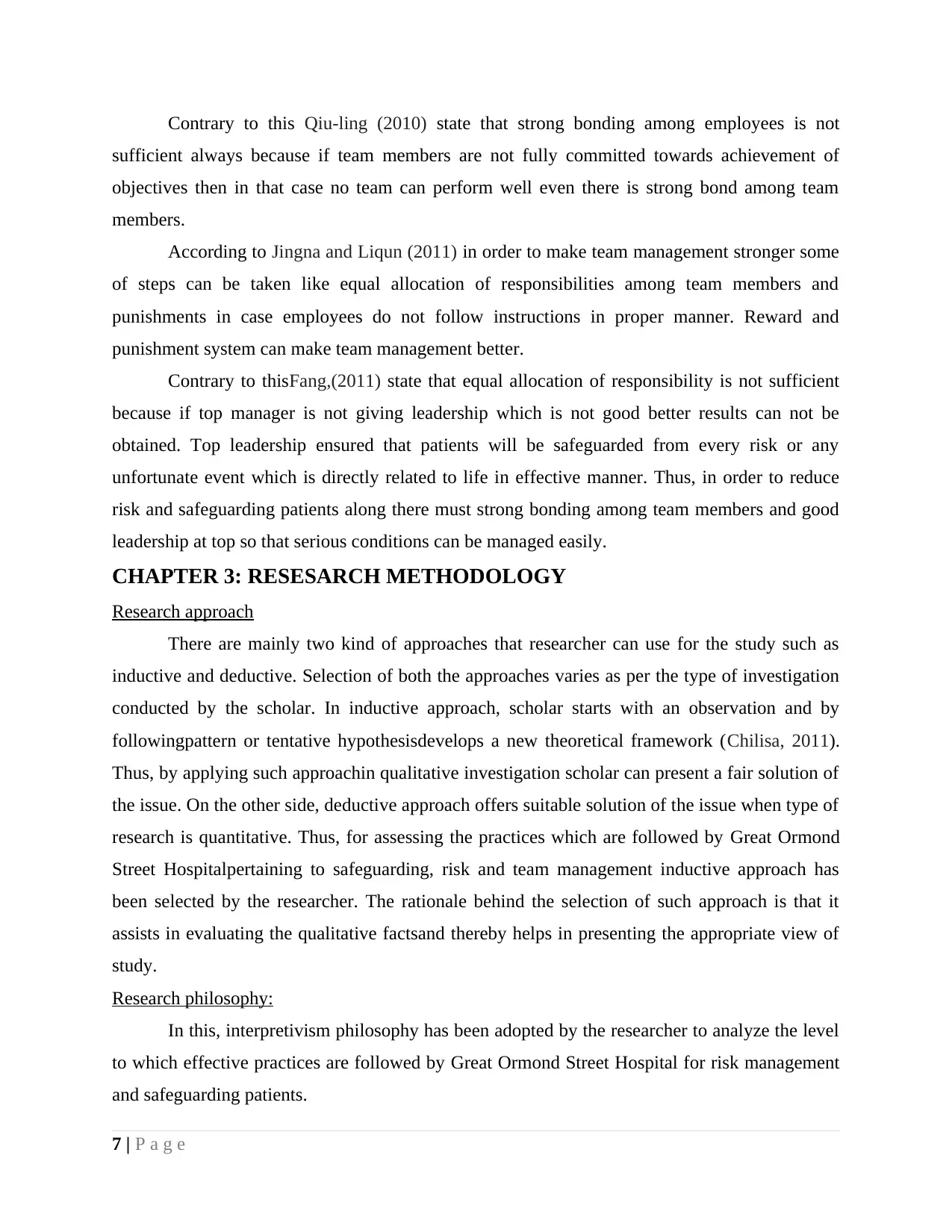
Contrary to this Qiu-ling (2010) state that strong bonding among employees is not
sufficient always because if team members are not fully committed towards achievement of
objectives then in that case no team can perform well even there is strong bond among team
members.
According to Jingna and Liqun (2011) in order to make team management stronger some
of steps can be taken like equal allocation of responsibilities among team members and
punishments in case employees do not follow instructions in proper manner. Reward and
punishment system can make team management better.
Contrary to thisFang,(2011) state that equal allocation of responsibility is not sufficient
because if top manager is not giving leadership which is not good better results can not be
obtained. Top leadership ensured that patients will be safeguarded from every risk or any
unfortunate event which is directly related to life in effective manner. Thus, in order to reduce
risk and safeguarding patients along there must strong bonding among team members and good
leadership at top so that serious conditions can be managed easily.
CHAPTER 3: RESESARCH METHODOLOGY
Research approach
There are mainly two kind of approaches that researcher can use for the study such as
inductive and deductive. Selection of both the approaches varies as per the type of investigation
conducted by the scholar. In inductive approach, scholar starts with an observation and by
followingpattern or tentative hypothesisdevelops a new theoretical framework (Chilisa, 2011).
Thus, by applying such approachin qualitative investigation scholar can present a fair solution of
the issue. On the other side, deductive approach offers suitable solution of the issue when type of
research is quantitative. Thus, for assessing the practices which are followed by Great Ormond
Street Hospitalpertaining to safeguarding, risk and team management inductive approach has
been selected by the researcher. The rationale behind the selection of such approach is that it
assists in evaluating the qualitative factsand thereby helps in presenting the appropriate view of
study.
Research philosophy:
In this, interpretivism philosophy has been adopted by the researcher to analyze the level
to which effective practices are followed by Great Ormond Street Hospital for risk management
and safeguarding patients.
7 | P a g e
sufficient always because if team members are not fully committed towards achievement of
objectives then in that case no team can perform well even there is strong bond among team
members.
According to Jingna and Liqun (2011) in order to make team management stronger some
of steps can be taken like equal allocation of responsibilities among team members and
punishments in case employees do not follow instructions in proper manner. Reward and
punishment system can make team management better.
Contrary to thisFang,(2011) state that equal allocation of responsibility is not sufficient
because if top manager is not giving leadership which is not good better results can not be
obtained. Top leadership ensured that patients will be safeguarded from every risk or any
unfortunate event which is directly related to life in effective manner. Thus, in order to reduce
risk and safeguarding patients along there must strong bonding among team members and good
leadership at top so that serious conditions can be managed easily.
CHAPTER 3: RESESARCH METHODOLOGY
Research approach
There are mainly two kind of approaches that researcher can use for the study such as
inductive and deductive. Selection of both the approaches varies as per the type of investigation
conducted by the scholar. In inductive approach, scholar starts with an observation and by
followingpattern or tentative hypothesisdevelops a new theoretical framework (Chilisa, 2011).
Thus, by applying such approachin qualitative investigation scholar can present a fair solution of
the issue. On the other side, deductive approach offers suitable solution of the issue when type of
research is quantitative. Thus, for assessing the practices which are followed by Great Ormond
Street Hospitalpertaining to safeguarding, risk and team management inductive approach has
been selected by the researcher. The rationale behind the selection of such approach is that it
assists in evaluating the qualitative factsand thereby helps in presenting the appropriate view of
study.
Research philosophy:
In this, interpretivism philosophy has been adopted by the researcher to analyze the level
to which effective practices are followed by Great Ormond Street Hospital for risk management
and safeguarding patients.
7 | P a g e
Paraphrase This Document
Need a fresh take? Get an instant paraphrase of this document with our AI Paraphraser
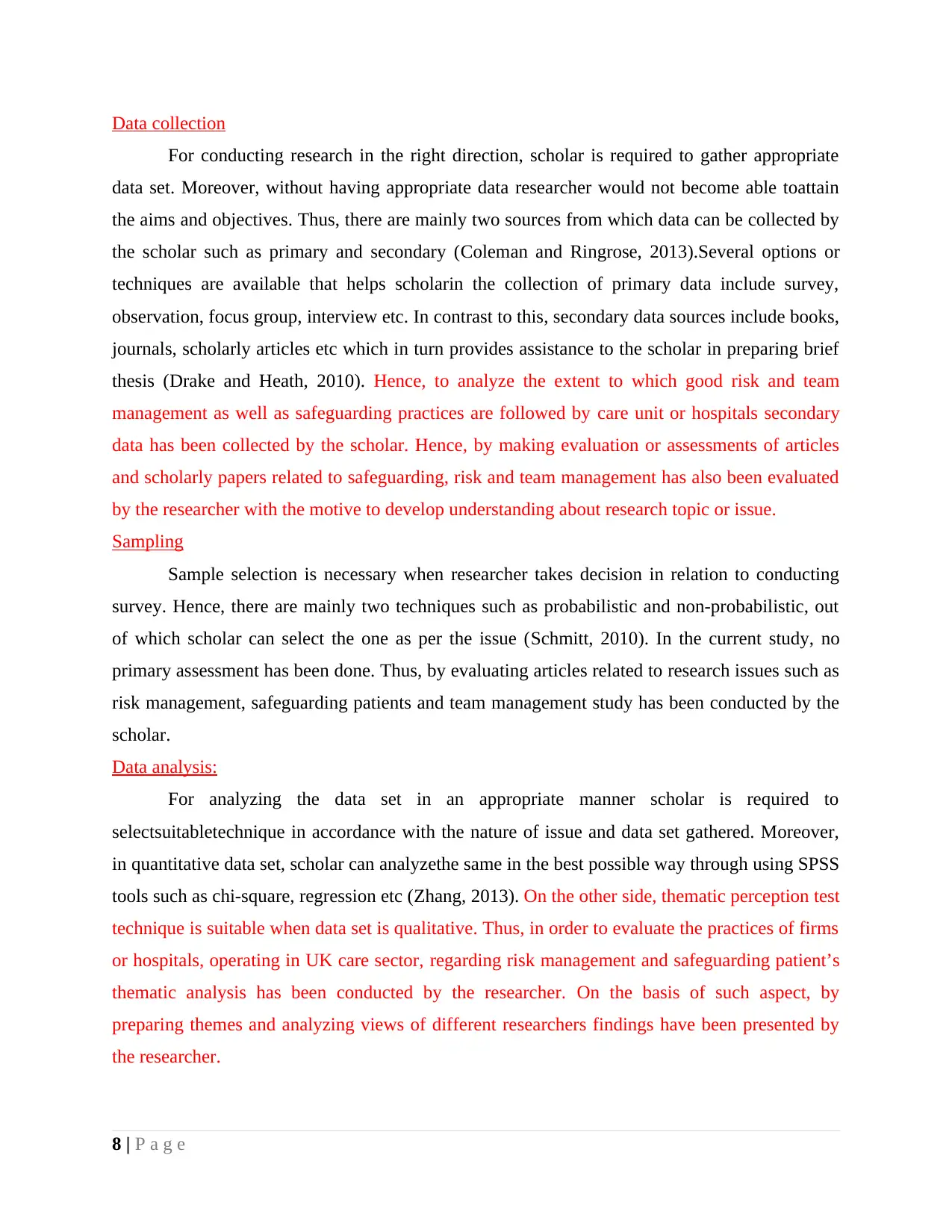
Data collection
For conducting research in the right direction, scholar is required to gather appropriate
data set. Moreover, without having appropriate data researcher would not become able toattain
the aims and objectives. Thus, there are mainly two sources from which data can be collected by
the scholar such as primary and secondary (Coleman and Ringrose, 2013).Several options or
techniques are available that helps scholarin the collection of primary data include survey,
observation, focus group, interview etc. In contrast to this, secondary data sources include books,
journals, scholarly articles etc which in turn provides assistance to the scholar in preparing brief
thesis (Drake and Heath, 2010). Hence, to analyze the extent to which good risk and team
management as well as safeguarding practices are followed by care unit or hospitals secondary
data has been collected by the scholar. Hence, by making evaluation or assessments of articles
and scholarly papers related to safeguarding, risk and team management has also been evaluated
by the researcher with the motive to develop understanding about research topic or issue.
Sampling
Sample selection is necessary when researcher takes decision in relation to conducting
survey. Hence, there are mainly two techniques such as probabilistic and non-probabilistic, out
of which scholar can select the one as per the issue (Schmitt, 2010). In the current study, no
primary assessment has been done. Thus, by evaluating articles related to research issues such as
risk management, safeguarding patients and team management study has been conducted by the
scholar.
Data analysis:
For analyzing the data set in an appropriate manner scholar is required to
selectsuitabletechnique in accordance with the nature of issue and data set gathered. Moreover,
in quantitative data set, scholar can analyzethe same in the best possible way through using SPSS
tools such as chi-square, regression etc (Zhang, 2013). On the other side, thematic perception test
technique is suitable when data set is qualitative. Thus, in order to evaluate the practices of firms
or hospitals, operating in UK care sector, regarding risk management and safeguarding patient’s
thematic analysis has been conducted by the researcher. On the basis of such aspect, by
preparing themes and analyzing views of different researchers findings have been presented by
the researcher.
8 | P a g e
For conducting research in the right direction, scholar is required to gather appropriate
data set. Moreover, without having appropriate data researcher would not become able toattain
the aims and objectives. Thus, there are mainly two sources from which data can be collected by
the scholar such as primary and secondary (Coleman and Ringrose, 2013).Several options or
techniques are available that helps scholarin the collection of primary data include survey,
observation, focus group, interview etc. In contrast to this, secondary data sources include books,
journals, scholarly articles etc which in turn provides assistance to the scholar in preparing brief
thesis (Drake and Heath, 2010). Hence, to analyze the extent to which good risk and team
management as well as safeguarding practices are followed by care unit or hospitals secondary
data has been collected by the scholar. Hence, by making evaluation or assessments of articles
and scholarly papers related to safeguarding, risk and team management has also been evaluated
by the researcher with the motive to develop understanding about research topic or issue.
Sampling
Sample selection is necessary when researcher takes decision in relation to conducting
survey. Hence, there are mainly two techniques such as probabilistic and non-probabilistic, out
of which scholar can select the one as per the issue (Schmitt, 2010). In the current study, no
primary assessment has been done. Thus, by evaluating articles related to research issues such as
risk management, safeguarding patients and team management study has been conducted by the
scholar.
Data analysis:
For analyzing the data set in an appropriate manner scholar is required to
selectsuitabletechnique in accordance with the nature of issue and data set gathered. Moreover,
in quantitative data set, scholar can analyzethe same in the best possible way through using SPSS
tools such as chi-square, regression etc (Zhang, 2013). On the other side, thematic perception test
technique is suitable when data set is qualitative. Thus, in order to evaluate the practices of firms
or hospitals, operating in UK care sector, regarding risk management and safeguarding patient’s
thematic analysis has been conducted by the researcher. On the basis of such aspect, by
preparing themes and analyzing views of different researchers findings have been presented by
the researcher.
8 | P a g e
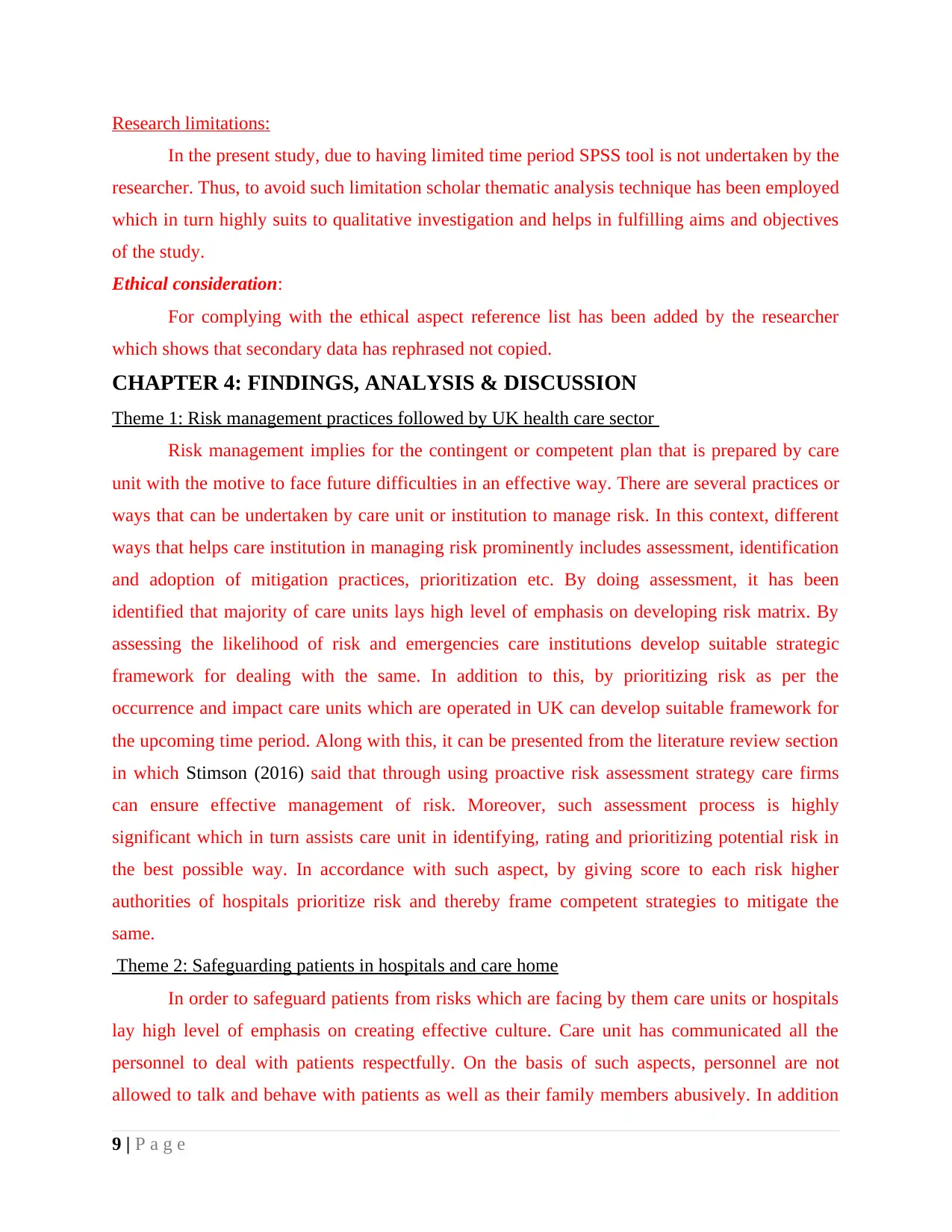
Research limitations:
In the present study, due to having limited time period SPSS tool is not undertaken by the
researcher. Thus, to avoid such limitation scholar thematic analysis technique has been employed
which in turn highly suits to qualitative investigation and helps in fulfilling aims and objectives
of the study.
Ethical consideration:
For complying with the ethical aspect reference list has been added by the researcher
which shows that secondary data has rephrased not copied.
CHAPTER 4: FINDINGS, ANALYSIS & DISCUSSION
Theme 1: Risk management practices followed by UK health care sector
Risk management implies for the contingent or competent plan that is prepared by care
unit with the motive to face future difficulties in an effective way. There are several practices or
ways that can be undertaken by care unit or institution to manage risk. In this context, different
ways that helps care institution in managing risk prominently includes assessment, identification
and adoption of mitigation practices, prioritization etc. By doing assessment, it has been
identified that majority of care units lays high level of emphasis on developing risk matrix. By
assessing the likelihood of risk and emergencies care institutions develop suitable strategic
framework for dealing with the same. In addition to this, by prioritizing risk as per the
occurrence and impact care units which are operated in UK can develop suitable framework for
the upcoming time period. Along with this, it can be presented from the literature review section
in which Stimson (2016) said that through using proactive risk assessment strategy care firms
can ensure effective management of risk. Moreover, such assessment process is highly
significant which in turn assists care unit in identifying, rating and prioritizing potential risk in
the best possible way. In accordance with such aspect, by giving score to each risk higher
authorities of hospitals prioritize risk and thereby frame competent strategies to mitigate the
same.
Theme 2: Safeguarding patients in hospitals and care home
In order to safeguard patients from risks which are facing by them care units or hospitals
lay high level of emphasis on creating effective culture. Care unit has communicated all the
personnel to deal with patients respectfully. On the basis of such aspects, personnel are not
allowed to talk and behave with patients as well as their family members abusively. In addition
9 | P a g e
In the present study, due to having limited time period SPSS tool is not undertaken by the
researcher. Thus, to avoid such limitation scholar thematic analysis technique has been employed
which in turn highly suits to qualitative investigation and helps in fulfilling aims and objectives
of the study.
Ethical consideration:
For complying with the ethical aspect reference list has been added by the researcher
which shows that secondary data has rephrased not copied.
CHAPTER 4: FINDINGS, ANALYSIS & DISCUSSION
Theme 1: Risk management practices followed by UK health care sector
Risk management implies for the contingent or competent plan that is prepared by care
unit with the motive to face future difficulties in an effective way. There are several practices or
ways that can be undertaken by care unit or institution to manage risk. In this context, different
ways that helps care institution in managing risk prominently includes assessment, identification
and adoption of mitigation practices, prioritization etc. By doing assessment, it has been
identified that majority of care units lays high level of emphasis on developing risk matrix. By
assessing the likelihood of risk and emergencies care institutions develop suitable strategic
framework for dealing with the same. In addition to this, by prioritizing risk as per the
occurrence and impact care units which are operated in UK can develop suitable framework for
the upcoming time period. Along with this, it can be presented from the literature review section
in which Stimson (2016) said that through using proactive risk assessment strategy care firms
can ensure effective management of risk. Moreover, such assessment process is highly
significant which in turn assists care unit in identifying, rating and prioritizing potential risk in
the best possible way. In accordance with such aspect, by giving score to each risk higher
authorities of hospitals prioritize risk and thereby frame competent strategies to mitigate the
same.
Theme 2: Safeguarding patients in hospitals and care home
In order to safeguard patients from risks which are facing by them care units or hospitals
lay high level of emphasis on creating effective culture. Care unit has communicated all the
personnel to deal with patients respectfully. On the basis of such aspects, personnel are not
allowed to talk and behave with patients as well as their family members abusively. In addition
9 | P a g e
⊘ This is a preview!⊘
Do you want full access?
Subscribe today to unlock all pages.

Trusted by 1+ million students worldwide
1 out of 19
Related Documents
Your All-in-One AI-Powered Toolkit for Academic Success.
+13062052269
info@desklib.com
Available 24*7 on WhatsApp / Email
![[object Object]](/_next/static/media/star-bottom.7253800d.svg)
Unlock your academic potential
Copyright © 2020–2025 A2Z Services. All Rights Reserved. Developed and managed by ZUCOL.





